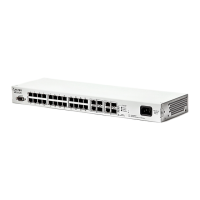42 MES1000, MES2000 Ethernet Switches
5 DEVICE MANAGEMENT COMMAND LINE INTERFACE
Four main modes are used for configuration of the switch. Each mode has its own specific set of
commands. Enter the '?' character to view the set of commands available for each mode.
Transition between modes is performed with special commands. The list of existing modes and
commands for mode transition:
Command mode (EXEC)—this mode is available right after the successful startup of the switch and
the username input. System prompt in this mode consists of the device name (host name) and '>'
character.
console>
If the device name is not defined, the word 'console' is used instead.
Privileged command mode (privileged EXEC)—this mode is available to privileged users after
logging in. This mode should be protected with a password. Commands for changing switch system
parameters are available in the privileged mode only. In the privileged mode, '#' character is used in the
system prompt. Use 'enable' command to enter the privileged mode from EXEC mode.
console> enable
enter password:
console#
Global configuration mode (global configuration)—this mode allows to specify general settings of
the switch. Global configuration mode commands are available in any configuration submode. Use
configure command to enter this mode.
console# configure
console(config)#
Interface configuration mode (interface configuration)—this mode is designed for configuration
of the switch interfaces (port, port group, VLAN interface). You can enter into this mode from the global
configuration mode; there is a specific command for each interface (in the example below shown the
configuration mode transition command for VLAN interface with VID=1).
console(config)# interface vlan 1
console (config-if)#
Terminal configuration mode (line configuration)—this mode is designed for terminal operation
configuration. You can enter this mode from the global configuration mode.
console(config)# line {console | telnet | ssh}
console(config-line)#

